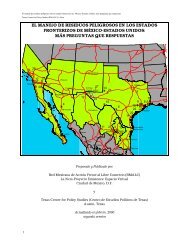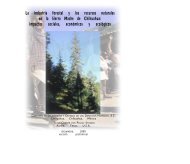Pesticides and Water Quality - Texas Center for Policy Studies
Pesticides and Water Quality - Texas Center for Policy Studies
Pesticides and Water Quality - Texas Center for Policy Studies
You also want an ePaper? Increase the reach of your titles
YUMPU automatically turns print PDFs into web optimized ePapers that Google loves.
D. Drinking <strong>Water</strong> MonitoringThis section reviews pesticide monitoring data <strong>for</strong> drinking water supply systems. <strong>Water</strong> utilities servingat least 25 persons or 15 connections at least 60 days a year are required to monitor <strong>for</strong> a number o<strong>for</strong>ganics, including pesticides. (Many of these systems, however, can apply <strong>for</strong> waivers from theserequirements). Toxic pollutant monitoring requirements <strong>for</strong> drinking water systems began as a result ofthe 1986 Safe Drinking <strong>Water</strong> Act. Currently, there are 54 organic chemicals <strong>for</strong> which MaximumContaminant Levels, or MCLs exist, <strong>and</strong> 33 additional organic compounds that must be monitored <strong>for</strong>,even though no MCL currently exists. Of these organics, 23 of the regulated MCL <strong>and</strong> 10 monitoredcontaminants are used or have been used as pesticide active ingredients. 32 If the average of fourconsecutive quarterly samples of these chemicals is above the MCL, then it is considered to be a violationof both state <strong>and</strong> federal drinking water st<strong>and</strong>ards. TNRCC implements the requirements of the federalSDWA <strong>and</strong> related <strong>Texas</strong> law.As described in more detail in Appendix A, some systems have waivers from pesticide monitoringrequirements. These waivers are granted after TNRCC conducts a “vulnerability assessment”, anevaluation of various factors to determine whether the water source is “vulnerable” to contamination. Thevast majority of waivers are granted to systems relying on ground water. About one-half of the over5,700 community <strong>and</strong> non-transient, non-community water systems in <strong>Texas</strong> have received waivers fromall pesticide monitoring based on TNRCC determinations that they are not “vulnerable” tocontamination. 33 In addition, TNRCC has granted statewide waivers <strong>for</strong> four pesticides: endothall <strong>and</strong>diquat (primarily used as aquatic herbicides), glyphosate (a widely used herbicide) 34 <strong>and</strong>dibromochloropropane.In those systems conducting sampling <strong>for</strong> pesticides, atrazine is the most frequently detected pesticide. Anumber of <strong>Texas</strong> systems have detected atrazine in finished drinking water (i.e. drinking water that goesto the tap) <strong>and</strong> a few have had individual quarterly samples above the MCL <strong>for</strong> atrazine (see Map 3 <strong>and</strong>Appendix B, Table B-1). In 1997 alone, <strong>for</strong> example, atrazine was detected in the tap water provided over60 public water supply systems. 35 These systems served at least four million people. Between 1995 <strong>and</strong>1997, over 80 public water supply systems detected atrazine in finished drinking water one or more times.Overall, nine water systems have exceeded the atrazine MCL at least once since drinking watermonitoring <strong>for</strong> organics began in 1993. In addition, the Aquilla <strong>Water</strong> Supply District in Hillsboro, HillCounty was in violation of the atrazine MCL <strong>and</strong> has exceeded the alachlor MCL on two occasions(Table 13). 36 Statewide, most of the MCL exceedences have been found in the spring, when atrazine useis higher <strong>and</strong> when rains are most likely to wash it into surface waters. 37In addition to the detections <strong>and</strong> exceedences of the MCL <strong>for</strong> alachlor <strong>and</strong> atrazine in some systems,many drinking water systems have detected other pesticides with frequency. Other pesticides that have32 Does not include two aldicarb breakdown products on unregulated contaminants monitoring list.33 <strong>Texas</strong> Natural Resource Conservation Commission, “Vulnerability Assessments”, www.tnrcc.state.tx.us /water/wu/swap/vapp.html, May 19, 1998. These systems still must sample once every three years <strong>for</strong> pesticides <strong>and</strong>other contaminants.34 TNRCC’s waiver <strong>for</strong> glyphosate is based on (1) glyphosate being reduced or eliminated by chlorination orozonation <strong>and</strong> (2) that the MCL <strong>for</strong> glyphosate is very high.35 <strong>Texas</strong> Natural Resource Conservation Commission, TNRCC Executive Management Briefing Paper Subject: AtrazineOccurrence in Public Drinking <strong>Water</strong> (Austin: TNRCC, August 19, 1997).36 In<strong>for</strong>mation from Organic Drinking <strong>Water</strong> Sampling Database, <strong>Water</strong> <strong>Quality</strong> Division, <strong>Texas</strong> Natural Resource ConservationCommission.37 <strong>Texas</strong> Natural Resource Conservation Commission, TNRCC Executive Management Briefing Paper Subject: AtrazineOccurrence in Public Drinking <strong>Water</strong> (Austin: TNRCC, August 19, 1997).17




